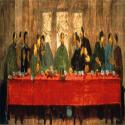Zhang, Hongtu
Other Names: ???; Hong Tu
Artist Website
Most of Zhang Hongtu's works are mixed media conceptual paintings. Zhang's images have frequently featured a central cutout, the edges of which form the silhouette of an well known cultural icons from both eastern and western culture. After the Chinese government crashed pro-democracy movement ,which has been called Tiananmen Square incident, Zhang has intensively created a series of the image of Chairman Mao Zedong as a symbol of pervasive power. These Mao images really made a splash that journals, magazines, advertisers, even trendy fashion houses adopted Zhang's work. However,
Mao's portrait is only one of the numerous cultural icons that Zhang has portrayed: the Buddha, the crucifixion of Christ, the cross, the holy trinity, ionic columns, traditional Chinese book bound with thread, and the Great Wall. In his effort of deconstructing those cultural icons, Zhang has developed and continued to use the two major techniques, cut out and contrast. As he cuts images out, positive becomes negative and solids turns into voids that central image is left unfilled. Zhang's purpose in using contrasting technique is to criticize commonly held value judgements of high and low and dispute the distinction between them. This is why and how those unfilled images are surrounded by basic raw materials such as oil, rice, grass, MSG, soy sauce, cement, nails and corns etc.. These two conflicting images of empty ground figure and mundane surrounding substances have been so successful in creating some sort of tension that they have induced a lot of viewers to question on high and low, common and grand and reality and illusion. Critics have praised this artist's work as "this is a clever work, one that at once elicits admiration for the artist's wit and uneasiness over his statement."(Lee Hui-Shu, "The Significance of a Bagel), "at once a tour de force and a farce, Last Banquet reinterprets a great Western religious painting as an emblem of Mao's egotism. Its audacity is compelling and, surprisingly, not without pathos." (Jonathan Goodman, Exhibition review)
Review by Young Park
Gallery of Selected Works
 Mi Youren - Monet (1999)
Mi Youren - Monet (1999)
 Soy Calligraphy: The Sweat Shop Help Wanted Ad, Wang Xizhi (321-379 A.D.) Style (1996)
Soy Calligraphy: The Sweat Shop Help Wanted Ad, Wang Xizhi (321-379 A.D.) Style (1996)
 B-3. A Scroll Painting (1990)
B-3. A Scroll Painting (1990)
 (Title Unknown) - installation for Tiananmen Show 1989 (1989)
(Title Unknown) - installation for Tiananmen Show 1989 (1989)
 Chairmen Mao (1989)
Chairmen Mao (1989)
 Last Banquet (1989)
Last Banquet (1989)
 Untitled #11 (1988)
Untitled #11 (1988)
 The Back of the Head #A (Relief) (1987)
The Back of the Head #A (Relief) (1987)
Selected Documents
- Article "Brushes Wielded Against Terror at Home" by Jessie Mangaliman in Newsday, June 23, 1989
- Article "紀念爭自由,參展不自由" by 林樂群 in 世界日報, June 30, 1990
- Review "Reflections Abroad: The Journey of Zhang Hongtu 1982-1996" by Jonathan Goodman in Art Asia Pacific, 1997
- Article "A Painter's Images of Mao as Reflected in a Changing China" by Helen A. Harrison in The New York Times, November 10, 1996
- Article "Zhang Hongtu" by Robert Lee in The Village Voice, Spring 1989
- Artist Resume, [2000]
- Excerpts from exhibition brochure for "Zhang Hongtu: Material Mao", The Bronx Museum of the Arts, 1995-1996
- Exhibition flyer for "The Angel's Ghost", Webster Hall, 1992
- Exhibition invitation card for "Zhang Hongtu New Paintings", Cheryl McGinnis Gallery, 2000
- Exhibition press release for "The Angel's Ghost", Webster Hall, 1992
- Green Artspiral Fall 1990
- Exhibition flyer for "China: June 4 1989", Asian American Arts Centre, 1989
- Excerpts from exhibition brochure for "China—June 4, 1989", Buckham Gallery, 1994
- Exhibition press release for "China—June 4, 1989", Buckham Gallery, 1994
- Exhibition flyer and poster for "The AAAC Story", Asian American Arts Centre, 2002
- Exhibition press release for "The AAAC Story", Asian American Arts Centre, 2002
- Excerpts from exhibition pamphlet for "Fire House: 25th Anniversary of Asian American Arts Centre", Ye Olde Fire House, 1999
- Exhibition flyer for "Fire House: 25th Anniversary of Asian American Arts Centre", Ye Olde Fire House, 1999
- Exhibition flyer for "From 'Star Star' to Avant Garde: 10 Artists from China", Asian American Arts Centre, 1991
- Article "From Shanghai to SoHo: For Chinese Expatriates, It's Art for Heart's Sake" by James Dao in Daily News, 1989
- Exhibition flyer for "Syncretism: The Art of the XXI Century", Alternate Museum, 1991
- Exhibition postcard for "China: June 4, 1989...", Reinberger Galleries, 1992
- Exhibition postcard for "Uptown/Downtown", City Gallery and Asian American Arts Centre, 1989
